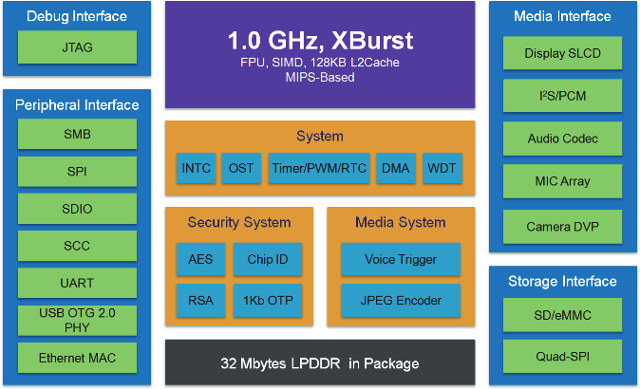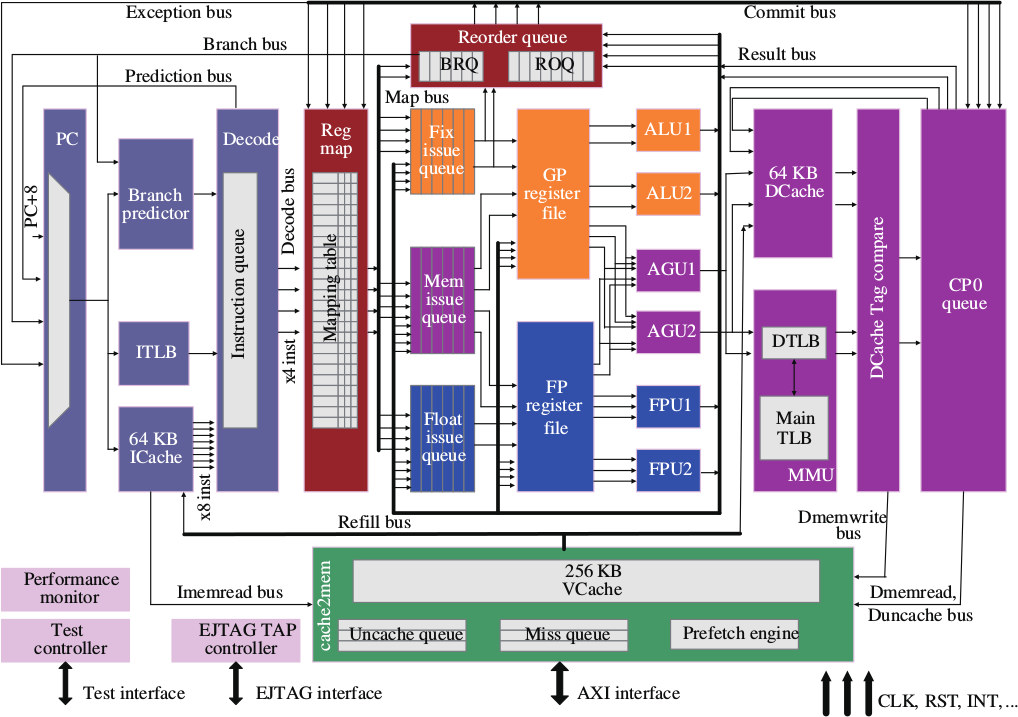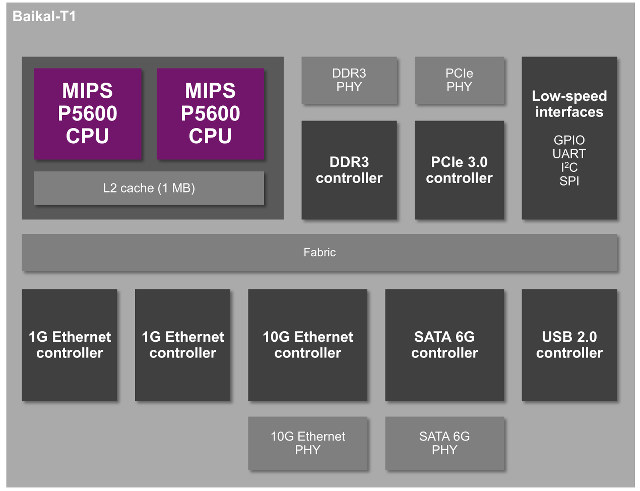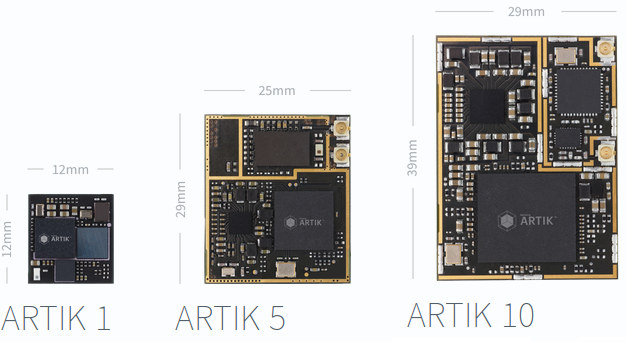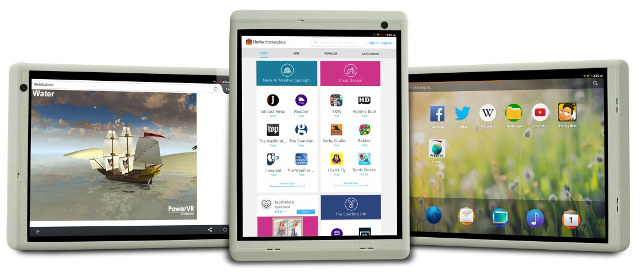Ingenic is a Chinese SoC vendor that makes processors featuring their X-Burst cores based on MIPS architecture. Their JZ47 series can be found in tablets and development boards such a MIPS Creator CI20, while their M series, including Ingenic M200, are dedicated to wearables & IoT applications. The company has now launched X series starting with X1000 processor which include an audio codec, a Voice Trigger Engine (VTE) and 32MB RAM in package. Ingenic X1000 features: CPU Core – Ingenic MIPS XBurst 32-bit core up to 1.0 GHz, Double precision hardware float point unit, L1 cache 16KB/16KB, and L2 cache 128KB Security Core – On-chip security ROM and RAM, hardware AES and RSA, supports security boot and user customization Memory 32MB LPDDR in package Support 16-bit DDR2, DDR3 and LPDDR up to 512MB Support Quad-SPI NOR/NAND, eMMC, SDHC Display – 8-bit, 9-bit, 16-bit parallel interface SLCD up to 640×480@60Hz, 24 […]
Loongson Introduces MIPS64 3A2000 & 3B2000 Processors Based on GS464E Architecture
Loongson recently unveiled two new quad core processors Loongson-3A2000 & Loongson-3B2000 targeting respectively consumer electronics and server, and on the company’s new GS464E architecture using MIPS64 cores. Both processors are 4-way superscalar processors built on a 9-stage, super-pipelined architecture with in-order execution units, two floating-point units, a memory management unit, and a crossbar interconnect. According to Imagination Technology, Chinese media reported that 3A2000 CPU was designed at high-performance consumer electronics products such as desktop computers and laptops, 64-bit embedded and DSP applications, and network routers, while 3B2000 will be used in 8 to 16 core server systems, meaning there would be 2 to 4 quad core processors in these servers. I could not find anything about the new processors on Loongson product page, but a white paper describes GS464E architecture in details. Unfortunately, the document is entirely in Chinese, except the abstract and some charts and tables: Loongson GS464E is […]
Linux 4.2 Release – Main Changes, ARM and MIPS Architectures
Linus Torvalds released Linux Kernel 4.2 last Sunday: So judging by how little happened this week, it wouldn’t have been a mistake to release 4.2 last week after all, but hey, there’s certainly a few fixes here, and it’s not like delaying 4.2 for a week should have caused any problems either. So here it is, and the merge window for 4.3 is now open. I already have a few pending early pull requests, but as usual I’ll start processing them tomorrow and give the release some time to actually sit. The shortlog from rc8 is tiny, and appended. The patch is pretty tiny too. Go get it, Linus Some notable changes made to Linux 4.2 include: File systems New features for F2FS including per file encryption CIFS support SMB 3.1.1 (experimental) Cryptography – Jitter Entropy Random Number Generator, Chacha20 stream cipher and Poly1305 authentication (RFC7539),New RSA implementation. See lwn.net […]
Baikal T1 is a Dual Core MIPS P5600 Communication Processor
When allegations surfaced that the NSA messed with devices manufactured by US companies, and possibly other, government of geopolitical significance started to take measures. For instance, China may have removed Apple and Cisco products from its list of approved products due to security reasons, and Russia decided to design its own Baikal processors to replace Intel and AMD solutions. At the time of the announcement, Baikal M and M/S chip were supposed to be the first ones and based on ARM Cortex A57 cores, but Imagination Technologies recently announced that Russia based Baikal Electronics was working on Baikal T1 communication processor with two MIPS P5600 cores. Some of the specifications include: CPU – Dual core MIPS 5600 processor @ 1.2 GHz with 1MB L2 cache Memory – DDR3 controller Storage – SATA 6Gbps controller and PHY Connectivity – 2x Gigabit Ethernet controller, 1x 10Gigabit Ethernet controller and PHY USB 2.0 […]
Samsung Artik is a Family of Arduino Compatible Boards for IoT Applications
There was a time when development boards were only reserved to companies, then boards like Arduino or Beagleboard made these available and affordable to consumers, and with the introduction of the Raspberry Pi, the maker movement grew even more rapidly, and many low cost boards started to be designed and manufactured mostly my smallest companies. But now larger companies like Intel or Qualcomm have jumped on the makers’ bandwagon, and the latest entry is Samsung with their Artik platform currently comprised of three boards that are programmable with the Arduino IDE. Let’s go through specifications for the three boards: Artik 1 SoC – Dual Core MIPS32 processor @ 250MHz (microAptiv UP) and 80MHz (microAptiv UC) without GPU Memory – 1MB RAM on-chip Storage – 4MB SPI flash Display – Up to WVGA (800×480) Connectivity – Bluetooth Low Energy with chip antenna Security – Secure element Sensor – 9-axis motion sensor […]
Linux 4.0 Release – Main Changes, ARM and MIPS Architectures
Linus Torvalds “Ima Sheep” released Linux Kernel 4.0 on Sunday: So I decided to release 4.0 as per the normal schedule, because there really weren’t any known issues, and while I’ll be traveling during the end of the upcoming week due to a college visit, I’m hoping that won’t affect the merge window very much. We’ll see. Linux 4.0 was a pretty small release both in linux-next and in final size, although obviously “small” is all relative. It’s still over 10k non-merge commits. But we’ve definitely had bigger releases (and judging by linux-next v4.1 is going to be one of the bigger ones). Which is all good. It definitely matches the “v4.0 is supposed to be a_stable_ release”, and very much not about new experimental features etc. I’m personally so much happier with time-based releases than the bad old days when we had feature-based releases. That said, there’s a few […]
Firefox OS Ported to MIPS Based Tablet (Ingenic JZ4780)
Imagination has announced that an experimental version of Firefox OS has been ported to a reference tablet powered by Ingenic JZ4780, a MIPS based processor, that’s also used in MIPS Creator CI20 development board, and that the company organized a raffle to send 15 of these tablets for people to try or develop on. The tablet is said to cost less than $100, runs either Firefox OS or Android 4.4 KitKat, and comes with the following specifications: SoC – Ingenic JZ4780 dual core MIPS32 processor @ 1.2 GHz with Imagination PowerVR SGX540 GPU. 32kI + 32kD per core, 512K shared L2. System Memory – N/A Storage – N/A Display – 9.7” screen; 1024 x 768 resolution Video Output – mini HDMI port Audio – Headphone jack, stereo speakers, microphone Connectivity – 802.11 b/g/n Wi-Fi, Bluetooth 4.0 USB – 1x Micro USB port Camera – Front and rear cameras Misc – […]
Ingenic Halley is a $20 Linux based IoT Board with Wi-Fi and Bluetooth 4.1 Connectivity
Ingenic introduced Newton2 platform for wearables a few months ago, and the kit with an AMOLED display, camera board and other accessories should go on sale in March for $80. In the meantime, the company has also been working on a lower cost internet of things (IoT) module and development kit powered by Ingenic M150 with Wi-Fi and Bluetooth 4.1 targeting smart appliances, Wi-Fi speakers, smart toys, industrial control applications, and other smart devices. Halley IoT module specifications: SoC – Ingenic M150 XBurst (MIPS) single-core processor up to 1.0GHz with 128MB LPDDR on-chip, 2D graphics GPU, VPU supporintg 720p30 H.264 video decoding. Storage – 8MP SPI NOR flash (GIGA GD25LQ64) Connectivity – Wi-Fi 802.11 b/g/n and Bluetooth 4.1 via Broadcom 43438 chip. Expansion headers (2mm pitch) 8-bit parallel LCD interface, Audio – MIC, Line-In and headphone, 2x I2S, SD card (MMC interface) USB device 2.0, and USB host 1.1 3x […]


